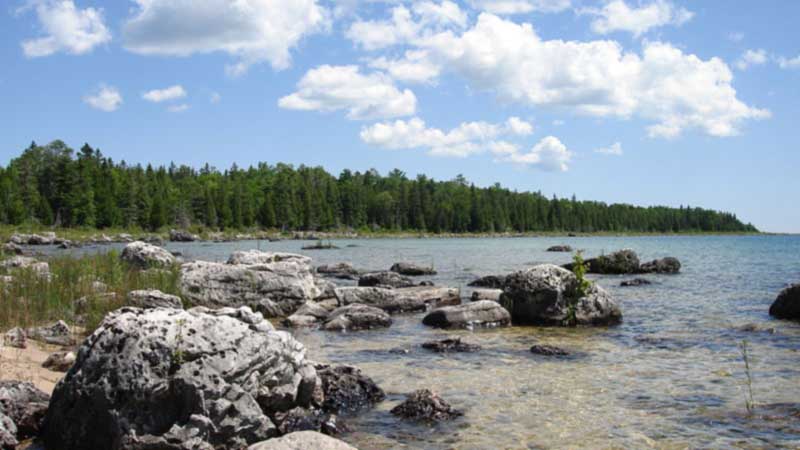MEAFORD – A proposal to develop an energy storage facility on a military base near Meaford utilizing Lake Huron has raised the ire of some local residents who have formed an organization called Save Georgian Bay, complete with Facebook page and online petition against the concept—which has yet to even make it to the drawing board.
The proposed $3.3 billion pumped storage facility would use electricity currently being produced at Ontario power plants during periods of low demand that can’t easily shut down to pump water from Lake Huron’s Georgian Bay uphill into a land-based storage reservoir on the Niagara Peninsula. The water would then be released back into the lake and run through turbines to produce hydro-electric power during periods of high demand—essentially creating a massive water-powered battery to store energy.
Proponents of the plan note that the facility would reduce reliance on fossil fuel generating plants and provide for a cost-effective means to store renewable energy, a key missing ingredient in the creation of a green energy power grid.
Opponents of the proposed facility allege the facility wold “change the lives of Georgian Bay residents and visitors and disrupt the natural beauty of Georgian Bay and the Niagara Escarpment forever (last word in all-caps).” Save Georgian Bay notes that the rate that water is pumped and released to and from Georgian Bay by the proposed facility would be “almost half the average flow over Niagara Falls.”
Save Georgian Bay has castigated TransCanada Energy (TCE) for its lack of public consultation on the proposed facility, but the company, which has its first public information meeting planned for December 11, says the project is too early in its planning stages to be able to answer most of the questions likely to be posed by the public.
“We are not there yet,” said TCE Senior Communications Specialist Jennifer Link, noting that before the project could even be rationally discussed a number of hurdles had to be passed, not the least of which was whether the project could even be based on the Canadian Forces base or whether the Department of National Defence (DND) would be interested in co-operating in the proposal. “Even to before the feasibility could be explored, DND had to examine whether they would be able to relocate their training to be able to co-locate with the facility.”
Despite the delay inherent in those initial government studies, there is a certain urgency to the proposal.
“Pickering (nuclear power station) will be coming off-line in 2014, taking 3,000 megawatts of power with it,” pointed out Ms. Link. “Although this is not a generation facility, it will store energy in periods of low demand.”
The plan sounds elegant and the ability to store green energy is attractive, but there will be impacts on the environment.
The project is barely a quarter through its feasibility phase and proponents are still investigating the regulatory phase.
The project will require local feedback, but there are a host of studies that must be completed before there are any answers, let alone whether those answers might be satisfactory to the opponents or allay any public concerns.
Save Georgian Bay has already held a number of public meetings on the project, decrying the lack of information or transparency of the project. TCE did offer to attend one of those recent meetings, but the organizers declined based on the short notice provided by the company and the lack of any ability to preview TCE slides that would be presented.
Concerns raised by the Save Georgian Bay group include that the project is based on a facility built in the 1960s in Ludington, Michigan of which they note: “After a 12-year court battle, the Ludington plant was required to construct a two-kilometre net and to pay millions in compensation to mitigate for the impacts it caused.” The group maintains that facility still kills millions of fish each year. “In essence, the plant serves as a giant food processor, mashing fish drawn into the turbines to satisfy its insatiable thirst,” reads the preamble to the group’s petition.
The project, notes Save Georgian Bay, will require the construction of “a huge concrete intake/outfall and three breakwaters extending from and parallel to the shoreline. These structures will be amongst the largest man-made structures in Georgian Bay. They will rival the pier in Collingwood for size. Yet, unlike the pier, these structures will be for the sole pleasure of TCE and will offer no recreational benefits to residents or visitors of Georgian Bay. Instead, they will destroy a stretch of beautiful pristine shoreline, restrict the passage of fish, wildlife and even small boats, interrupt the natural movement of sediment along the shoreline, cloud our beautifully clear waters, and smother fish spawning and rearing habitats.”
“The pipeline that conveys water to and from the man-made reservoir will extend approx. 1.7 kilometres inland, cutting a corridor up the Niagara Escarpment—one of the world’s natural wonders that it has been recognized as a UNESCO World Biosphere Reserve.”
“The electricity supplied to the plant will come from new high voltage transmission lines to be run through the beautiful residential properties and farmlands of Grey County and Essa Township. This extends the area impacted by the proposed plant far beyond the shoreline of Georgian Bay,” they point out.
“All infrastructure has its challenges,” admitted Ms. Link. “We are not really surprised there is opposition to the project, but it is early days and there has not been an opportunity to explain the benefits.”
While the Ludington facility is a precursor to this project, there are a number of other such facilities around the globe, and the construction and operation of those facilities will help to inform the studies exploring the feasibility of the Meaford project.
As the project enters its regulatory phase, there will be studies on fish habitat, water resources, environmental protection studies and a “lot of engagement,” Ms. Link said.
There are over 100 megawatts of such facilities worldwide, noted Ms. Link, 20 megawatts of which are currently in operation in North America. China has been investing in the technology to a heavy extent in recent years.
Some systems operate on a closed loop basis, with both ends of the pumped water contained in reservoirs. But those types of systems require a “significant increase in costs and a number of other trade-offs,” said Ms. Link.
The project is anticipated to create at least 400 jobs during its construction phase, but will likely employ only 15 when complete. “But these few jobs pale in comparison to the employment loss associated with tourism, recreation and residential growth that only exist because of the natural beauty of the lands and waters TCE intends to exploit,” posits Save Georgian Bay.
The Save Georgian Bay group notes that there are other energy storage technologies available that would have less impact on the landscape, using somewhat pejorative language to make their point: “Perhaps TCE executives should speak with Elon Musk (or any fifth grader).”
Ms. Link agrees that is true there are other competing technologies, pointing to a giant battery facility currently being constructed in Alberta, but she also points out those facilities have their own trade-offs both environmentally and in cost competitiveness.
It might be early days in the project, with little to go by but speculation and alarm, but the Save Georgian Bay group has been marshalling its forces to oppose the plan. An online petition has garnered 11,888 of a planned 15,000 signatories even before the project has fully reached the drawing board.




